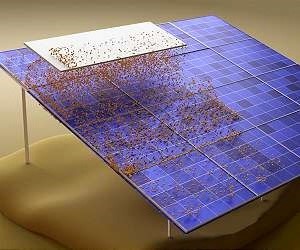In the future, decarbonized societies that use internet of things (IoT) devices will become commonplace. But to achieve this, we need to first realize highly efficient and stable sources of renewable energy. Solar cells are considered a promising option, but their electrical contacts suffer from a ‘tradeoff’ relationship between surface passivation and conductivity. Recently, researchers from Japan have developed a new type of electrical contact that can overcome this problem.
The most recent type of commercial photovoltaic cell (solar cell) uses stacked layers of crystalline silicon (c-Si) and an ultrathin layer of silicon oxide (SiOx) to form an electrical contact. The SiOx is used as a ‘passivating’ film-an unreactive layer that improves the performance, reliability, and stability of the device.
But that does not mean that simply increasing the thickness of this passivating layer will lead to improved solar cells. SiOx is an electrical insulator and there is a trade-off relationship between passivation and the conductivity of the electrical contact in solar cells.
In a new study, published in ACS Applied Nano Materials, a research team led by Assistant Professor Kazuhiro Gotoh and Professor Noritaka Usami from Nagoya University has developed a novel SiOx layer that simultaneously allows high passivation and improved conductivity. Named NAnocrystalling Transport path in Ultrathin dielectrics for REinforcing passivating contact (NATURE contact), the new electrical contact consists of three-layer structures made up of a layer of silicon nanoparticles sandwiched between two layers of oxygen-rich SiOx.
“You can think of a passivating film as a big wall with gates in it. In the NATURE contact, the big wall is the SiOx layer and the gates are Si nanocrystals,” explains Dr. Gotoh.
The conductivity of the electrical contact in solar cells is dependent on the formation of a ‘carrier pathway’ for the transport of electronic charges. The formation of this electrical pathway is dependent upon a high temperature treatment called ‘annealing.’
Previous research has shown that SiOx contacts that contain silicon nanoparticles as a carrier pathway can achieve good electrical properties. In the NATURE contact, the annealing process leads to the formation of very small silicon nanocrystals in the passivation layer that are nearly spherical in shape. The diameter of these nanocrystals corresponds to the thickness of the passivation layer. Thus, by controlling the annealing conditions, the diameter and subsequent thickness of the passivation layer can be adjusted.
The research team fabricated NATURE contacts and then subjected them to varying annealing conditions. Upon studying the contacts with transmission electron microscopy, they discovered that silicon nanocrystals were formed in the contact at an annealing temperature of 750C.
They also investigated the electrical properties of the contact. They saw that compared to existing contacts such as the tunnel oxide passivating contact (TOPCon) or polysilicon on the oxide (POLO) contacts, the NATURE had comparable values of contact resistance and ‘recombination current,’-a phenomenon that causes current and voltage losses in solar cells and decreases their efficiency.
“The NATURE contact overcomes the trade-off relationship between the protective ability and conductivity of passivating films. This development will lead to the realization of future building-integrated photovoltaics (BIPV) and vehicle-integrated photovoltaics (VIPV) and help us achieve zero-energy buildings and solar cars in future decarbonized societies,” concludes Dr. Gotoh.
Research Report: “Silicon Nanocrystals Embedded in Nanolayered Silicon Oxide for Crystalline Silicon Solar Cells”
Related Links
Nagoya University
All About Solar Energy at SolarDaily.com
|
We need your help. The SpaceDaily news network continues to grow but revenues have never been harder to maintain. With the rise of Ad Blockers, and Facebook – our traditional revenue sources via quality network advertising continues to decline. And unlike so many other news sites, we don’t have a paywall – with those annoying usernames and passwords. Our news coverage takes time and effort to publish 365 days a year. If you find our news sites informative and useful then please consider becoming a regular supporter or for now make a one off contribution. |
||
|
SpaceDaily Contributor $5 Billed Once credit card or paypal |
SpaceDaily Monthly Supporter $5 Billed Monthly paypal only |
|

![]()
How to clean solar panels without water
Boston MA (SPX) Mar 13, 2022
Solar power is expected to reach 10 percent of global power generation by the year 2030, and much of that is likely to be located in desert areas, where sunlight is abundant. But the accumulation of dust on solar panels or mirrors is already a significant issue – it can reduce the output of photovoltaic panels by as much as 30 percent in just one month – so regular cleaning is essential for such installations.
But cleaning solar panels currently is estimated to use about 10 billion gallons of wate … read more
